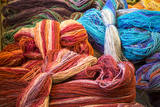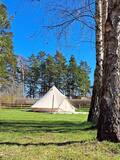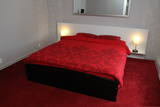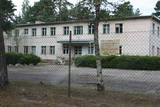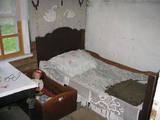| Nr | Name | Beschreibung |
|---|---|---|
|
Die Beerenplantage Sutri befindet sich in der gleichnamigen Gemeinde im Bezirk Livani. Auf dem Hof werden Erdbeeren und Heidelbeeren angebaut, und zwar im Tunnelanbau (unter Folie), weswegen die Reife früher einsetzt als sonst in Lettland. Die Beeren werden sowohl vor Ort als auch auswärts verkauft. |
||
|
Путешествие для гурманов и любителей путешествий, в котором будет возможность попробовать не только традиционные курземские блюда, как скландраусис и копчушка, но и блины, приготовленные из свежемолотой муки, крестьянский сыр, домашнее вино и другие дары села. Кроме дегустации даров села, будет возможность пройтись по природным тропам и познакомиться с культурно-историческим наследием. Информация о маршруте от Latvijas Lauku forums |
||
|
Dieser Komplex befindet sich am südlichen Ufer des Sees Ludza, Auf vorheriger Anmeldung können hier Gruppen von Touristen Mahlzeiten bestellen, hier werden Mahlzeiten für Hochzeiten und andere Feste organisiert. |
||
|
No Vilces muižas pa pastaigu taku var aiziet līdz pilskalnam (12 m virs apkārtnes, labiekārtots), kas atrodas Vilces un Rukūzes upīšu satekā. Atradumi liecina, ka cilvēku apmetne šeit ir pastāvējusi jau vidējā dzelzs laikmetā. Pilskalna piekājē atrodas atpūtai labiekārtotā Zaķu pļava. Nostāsti vēsta, ka Vilces grava bijusi laupītāja Kaupēna slēpšanās vieta. |
||
|
Beķereja, veikals un kafejnīca atrodas Vaiņodes centrā. Saimniece cep pīrāgus, cepumus un plātsmaizes Latgales meistara mūrētā maizes krāsnī, gatavo tradicionāli latviskus ēdienus, klāj svētku galdus. Beķerejas veikalā var iegādāties ceptuves gardumus un uzzināt par apkaimes interesantākajām vietām. Par dienas aktuālo piedāvājumu beķerejas saimniece ziņo facebook.com/ineta.zveja . |
||
|
Ein 3,5 km langer Pfad quert den Viru Moos in Richtung Süd–Nord. Von einem Holzaussichtsturm eröffnet sich einen Blick auf eine typische Hochmoorlandschaft mit einigen Seen, Aushöhlungen und morastigen Stellen. |
||
|
This is the only factory in Latvia that offers the full processing of wool, and it has been open since the late 19th century. There is a workshop in Dundaga where woollen blankets and pillows are sewn. |
||
|
Bērzciema Lagūna ir atpūtas vieta zvejnieku ciematā Bērzciemā. Tiek piedāvātas divas teltis, katra ir 28 kvadrātmetrus liela, ar visām nepieciešamajām ērtībām, tostarp divguļamo gultu un atpūtas zonu. Viesu rīcībā ir arī pašapkalpošanās virtuve, āra duša un piknika vietas. Pēc iepriekšējas vienošanās vienā teltī maksimāli var izmitināt 4 personas. Piedāvājumā ir arī velosipēdu un SUP noma, telšu vietas un peldvieta jūrā. Glempings atrodas Enguras ezera Dabas parkā, kurā ir vairākas dabas takas, kā arī Engures ezera dabas taka ar savvaļas dzīvniekiem un putnu novērošanas torni un orhideju taka.
|
||
|
Ekskursijas laikā apmeklējiet dabas taku, kura izvijas augšup un lejup gar Pilsupes lejteces stāvajiem krastiem un atklāj skaistus skatus uz trīs balto smilšu atsegumiem, no kuriem vecākais ir 6000 gadu vecs. Pēc tam apmeklējiet Kubalu skolu - muzeju, kur redzēsiet, kādas izskatījās skolas 19 gs. Klasē Jūs sagaida senie skolas soli, tāfelītes, tinte un rakstāmspalva. Tālāk dodieties uz dabas parku, kurā izveidota Bišu taka. Iespēja kāpt kokā ar dzeiņa palīdzību, liet vaska sveces un iepazīt dažādos biškopības produktus. Ekskursijas noslēgumā dodieties uz mini zoo, kur ir iespēja apskatīt dažādus dzīvnieciņus - pundurkaziņas, punduraitiņas, mandarīnpīles. |
||
|
Here you will find some 30 types of birds and animals, including cranes, pheasants, swans, pygmy sheep, pygmy pigs, kangaroos, squirrels, etc. You can take a tour and learn about the animals, or walk through the garden on your own. You can also purchase rare and exotic plants from the farm’s garden. |
||
|
Saimniecībā tiek piedāvāti dažādi biškopības produkti: medus, bišu maize, propoliss, vaska sveces. Iespēja sarunāt izzinošu ekskursiju - ceļojums bišu pasaulē ar gulēšanu uz bitēm. Tiek piedāvāta arī loku šaušana un zāļu tējas. |
||
|
Guest house AMRAI is located in Ventspils, in a quiet, tidy area, 6 km from the central beach and 2 km from the wild beach. For accommodation we offer a well-equipped two-storey holiday house with two separate rooms, as well as well-equipped 1-room and 3-room apartments in a private house with separate entrances from the yard. The one-room apartment has a shower, toilet, kitchen, TV - local, internet. The three-room apartment has a jacuzzi bath, toilet, kitchen, TV-spot, internet. Both apartments have a washing machine. In the garden there is a place for games, trampolines, grills. Offers board games and outdoor games - free of charge. Possibility to order meals, talk to a babysitter, rent bicycles. |
||
|
The farm produces mixes involving seeds from various plants – ones which are very healthy in terms of human nutrition. Visitors will hear stories, purchase products and taste hemp pancakes. The tour takes place at the “Mazais Ansis” saloon. |
||
|
Auch heutiges Territorium der Grenzwache in Pāvilosta ist für Zivilpersonen geschlossen. Das Territorium wird für Bedürfnissen der Seestreitkräfte genutzt.
|
||
|
"Dobele Agra S.I.A." ir moderns, nākotnes perspektīvā domājošs lauksaimniecības uzņēmums Latvijā. "Dobele Agra S.I.A.", kas atrodas netālu no Dobeles - Krimūnās, kā viens no lielākajiem aramzemes apstrādātājiem Latvijā pašlaik apstrādā apmēram 5 800 ha lauksaimniecības zemes Dobeles un Jelgavas rajonos. Uzņēmums specializējas graudaugu audzēšanā pārdošanai vietējos un starptautiskajos tirgos, tādējādi gadā tiek saražotas apmēram 20 00 - 25 000 tonnas graudaugu, no kuriem lielākā daļa ir kvieši mieži, rapsis un pākšaugi. Pārsvarā tiek audzētas ziemas šķirnes. |
||
|
Meklējams Ostas ielas promenādes malā, 100 m ziemeļaustrumos no Ventspils Livonijas ordeņa pils. Veltīts jaunlatviešu kustības aizsācējam, publicistam un politiķim, kā arī pirmās Latvijas jūrskolas dibinātājam. Uz soliņa sēdošais Krišjānis ar savu skatu „pavada” katru ostā ienākošo izejošo kuģi. |
||
|
Eine der neuesten Städte in Lettland. Im Jahr 2013 wird die Stadt ihr 20. Jubiläum feiern. In Salaspils befinden sich mehrere in Lettland bedeutende wissenschaftliche Institutionen (während der Sowjetzeit wurde die Stadt zu einem Zentrum für Wissenschaft gebildet): Institut für Biologie, Institut für anorganische Chemie, Institut für Physik, der Nationale Botanische Garten. Während der Sowjetzeit befanden sich hier der ehemalige Kernreaktor von Salaspils und das Institut für Forstwissenschaft Silava. In den letzten zehn Jahren hat sich die Infrastruktur der Stadt entwickelt, es sind mehrere große Bezirke mit Einfamilienhäusern entstanden. Im Jahr 1996 wurde in Salaspils eine neue katholische Kirche gebaut. Ihrem Wesen nach ist die Stadt ein Schlafbezirk der Hauptstadt Riga. |
||
|
Reškutenu (Reškutėnai) ciema apkārtnē ir atjaunots neliels mitrājs, kura malā uzcelts putnu vērošanas tornis. Ja paveicas, pavasaros te var dzirdēt vai redzēt tādas retas un aizsargājamas putnu sugas kā ķikutu Gallinago media, ormanīti Porzana porzana, melnkakla dūkuri Podiceps nigricollis, griezi Crex crex u.c. Ciema ainava īpaši pievilcīga ir pieneņu un ābeļu ziedēšanas laikā. No putnu vērošanas torņa var redzēt vietas, kur akmens laikmetā dzīvojuši cilvēki. Blakus esošajā purvainajā pļavā bijis ezera līcis, kur tika būvēti ciemati līdzīgi kā Āraišu ezerpils gadījumā. |
||
|
Der älteste Teil der jetzigen Wohnriege ist die Riegenstube mit dem Erdfussboden aus 19.Jh. Das Wohnzimmer mit Kammern wurde in der II. Hälfte des XIX. Jahrhunderts gebaut. |
||
|
Das Schloss befindet sich in Krustpils, in der Rīgas Straße 216 b. Die Anfänge des Schlosses sind im Jahr 1237 zu suchen. Damals hat der Bischof von Riga Nikolai aus Magdeburg die Burg von Krustpils gebaut, die die erste befestigte Burg der Kreuzritter in der Region Latgale war. Vom Ende des 16. Jhs. bis zum Anfang des 20. Jhs. gehörte das Schloss dem Ritter Nikolai Korff (und seiner Familie). Das Schloss hat mehrmals unter Kriegen gelitten und ist umgebaut worden, aber trotzdem hat es bis heute seinen eingeschlossenen Hof erhalten, der den mittelalterlichen Burgen charakteristisch war. Mitte des 19. Jhs. bekommt das Schloss die heutige Innenausstattung des Historismus, aber es haben sich auch Elemente der älteren Bebauung erhalten: der Torturm, Hauptwände, Schießluken, Gewölbekonstruktionen, Fensternischen u.a. Während der Sowjetzeit befand sich in dem Schloss die Sowjetarmee, aber neben dem Schloss wurde die sogenannte Kriegsstadt eingerichtet, die heute Pils rajons (der Bezirk des Schlosses) genannt und der von der westlichen Seite von dem Teich Pils dīķis (Teich des Schlosses) eingeschlossen wird. Im Jahr 1994 wurde in dem Schloss das Geschichtsmuseum von Jēkabpils eingerichtet, das man unter der Leitung eines Reiseleiters oder individuell besichtigen kann. Zurzeit ist das Schloss eine der wenigen Sehenswürdigkeiten in Lettland, die man mit Hilfe eines Audio-Reiseführers kennenlernen kann. Von dem Schlossturm bietet sich eine schöne Aussicht. |
||







